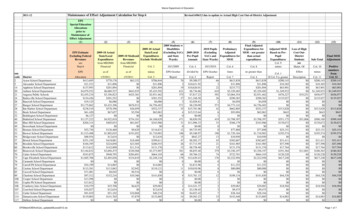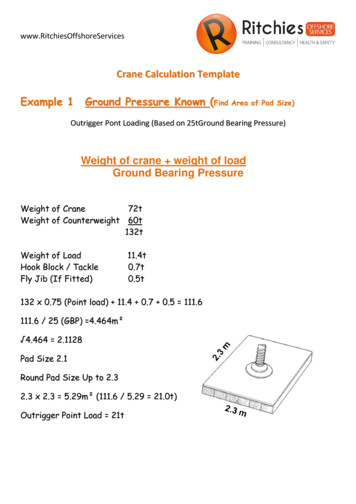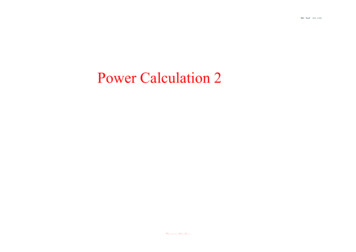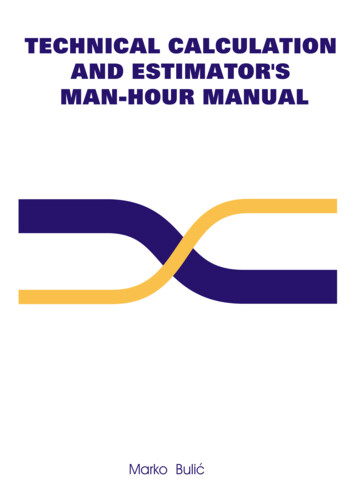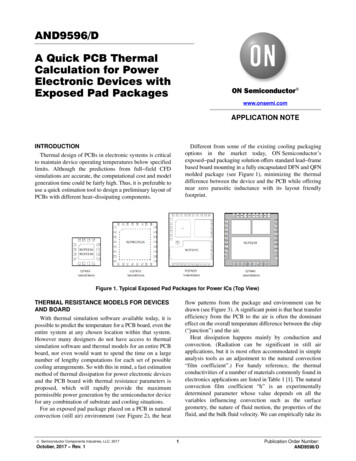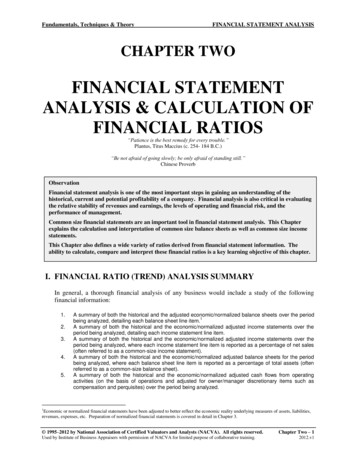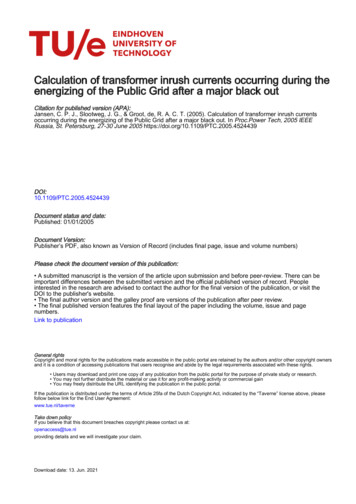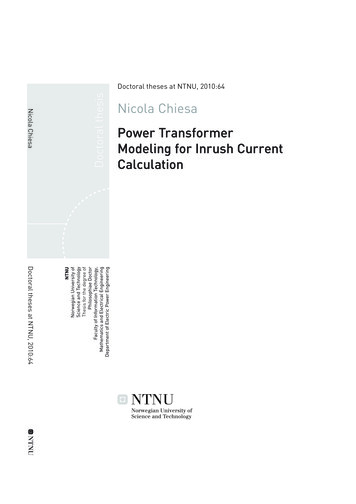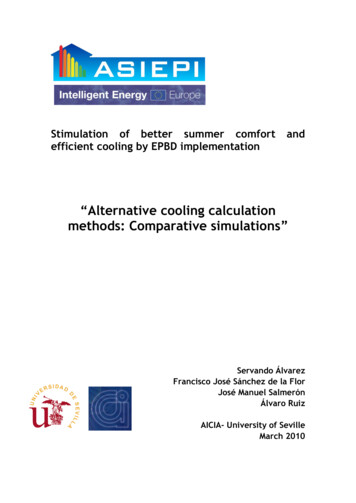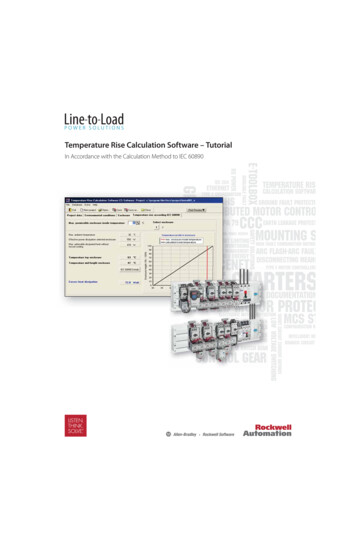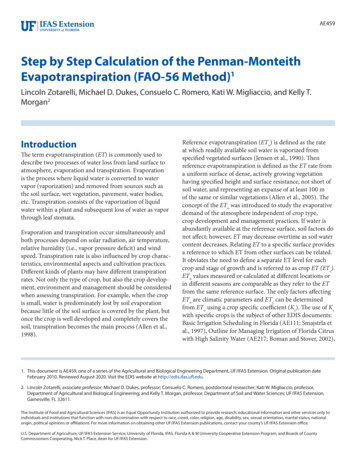
Transcription
AE459Step by Step Calculation of the Penman-MonteithEvapotranspiration (FAO-56 Method)1Lincoln Zotarelli, Michael D. Dukes, Consuelo C. Romero, Kati W. Migliaccio, and Kelly T.Morgan2IntroductionThe term evapotranspiration (ET) is commonly used todescribe two processes of water loss from land surface toatmosphere, evaporation and transpiration. Evaporationis the process where liquid water is converted to watervapor (vaporization) and removed from sources such asthe soil surface, wet vegetation, pavement, water bodies,etc. Transpiration consists of the vaporization of liquidwater within a plant and subsequent loss of water as vaporthrough leaf stomata.Evaporation and transpiration occur simultaneously andboth processes depend on solar radiation, air temperature,relative humidity (i.e., vapor pressure deficit) and windspeed. Transpiration rate is also influenced by crop characteristics, environmental aspects and cultivation practices.Different kinds of plants may have different transpirationrates. Not only the type of crop, but also the crop development, environment and management should be consideredwhen assessing transpiration. For example, when the cropis small, water is predominately lost by soil evaporationbecause little of the soil surface is covered by the plant, butonce the crop is well developed and completely covers thesoil, transpiration becomes the main process (Allen et al.,1998).Reference evapotranspiration (ETo) is defined as the rateat which readily available soil water is vaporized fromspecified vegetated surfaces (Jensen et al., 1990). Thenreference evapotranspiration is defined as the ET rate froma uniform surface of dense, actively growing vegetationhaving specified height and surface resistance, not short ofsoil water, and representing an expanse of at least 100 mof the same or similar vegetations (Allen et al., 2005). Theconcept of the ETo was introduced to study the evaporativedemand of the atmosphere independent of crop type,crop development and management practices. If water isabundantly available at the reference surface, soil factors donot affect; however, ET may decrease overtime as soil watercontent decreases. Relating ET to a specific surface providesa reference to which ET from other surfaces can be related.It obviates the need to define a separate ET level for eachcrop and stage of growth and is referred to as crop ET (ETc).ETo values measured or calculated at different locations orin different seasons are comparable as they refer to the ETfrom the same reference surface. The only factors affectingETo are climatic parameters and ETc can be determinedfrom ETo using a crop specific coefficient (Kc). The use of Kcwith specific crops is the subject of other EDIS documents:Basic Irrigation Scheduling in Florida (AE111; Smajstrla etal., 1997), Outline for Managing Irrigation of Florida Citruswith High Salinity Water (AE217; Boman and Stover, 2002),1. This document is AE459, one of a series of the Agricultural and Biological Engineering Department, UF/IFAS Extension. Original publication dateFebruary 2010. Reviewed August 2020. Visit the EDIS website at http://edis.ifas.ufl.edu.2. Lincoln Zotarelli, associate professor; Michael D. Dukes, professor; Consuelo C. Romero, postdoctoral researcher; Kati W. Migliaccio, professor,Department of Agricultural and Biological Engineering; and Kelly T. Morgan, professor, Department of Soil and Water Sciences; UF/IFAS Extension,Gainesville, FL 32611.The Institute of Food and Agricultural Sciences (IFAS) is an Equal Opportunity Institution authorized to provide research, educational information and other services only toindividuals and institutions that function with non-discrimination with respect to race, creed, color, religion, age, disability, sex, sexual orientation, marital status, nationalorigin, political opinions or affiliations. For more information on obtaining other UF/IFAS Extension publications, contact your county’s UF/IFAS Extension office.U.S. Department of Agriculture, UF/IFAS Extension Service, University of Florida, IFAS, Florida A & M University Cooperative Extension Program, and Boards of CountyCommissioners Cooperating. Nick T. Place, dean for UF/IFAS Extension.
A Web-Based Irrigation Scheduling Model to ImproveWater Use Efficiency and Reduce Nutrient leaching forFlorida Citrus (SS499; Morgan et al., 2009), IrrigationScheduling for Tropical Fruit Groves in South Florida(AE21; Migliaccio and Li, 2000), Smart Irrigation controllers: Programming Guidelines for EvapotranspirationBased Irrigation Controllers (AE445; Dukes et al., 2009)and Principle and Practices of Irrigation Management forVegetables (Simonne et al., 2010).A large number of empirical methods have been developedover the last 50 years to estimate evapotranspiration fromdifferent climatic variables. Some of these derived fromthe now well-known Penman equation (Penman, 1948) todetermine evaporation from open water, bare soil and grass(now called evapotranspiration) based on a combination ofan energy balance and an aerodynamic formula, given as:where λE evaporative latent heat flux (MJ m-2 d-1), Δ slope of the saturated vapor pressure curve [ δeo/ δT, whereeo saturated vapor pressure (kPa) and Tmean daily meantemperature (oC)]; Rn net radiation flux (MJ m-2 d-1), G sensible heat flux into the soil (MJ m-2 d-1), γ psychrometric constant (kPa oC-1), and Ea vapor transport of flux(mm d-1).Various derivation of the Penman equation included a bulksurface resistance term (Monteith, 1965) and the resultingequation is now called the Penman-Monteith equation,which may be expressed for daily values as:where ρa air density (kg m-3), Cp specific heat of dry air,eso mean saturated vapor pressure (kPa) computed as themean eo at the daily minimum and maximum air temperature (ºC), rav bulk surface aerodynamic resistance forwater vapor (s m-1), ea mean daily ambient vapor pressure(kPa) and rs the canopy surface resistance (s m-1).An updated equation was recommended by FAO (Allenet al. 1998) with the FAO-56 Penman-Monteith Equation,simplifying equation [2] by utilizing some assumedconstant parameters for a clipped grass reference crop. Itwas assumed that the definition for the reference crop wasa hypothetical reference crop with crop height of 0.12 m, afixed surface resistance of 70 s m-1 and an albedo value (i.e.,portion of light reflected by the leaf surface) of 0.23 (Smithet al., 1992). The new equation is:where ETo reference evapotranspiration rate (mm d-1), T mean air temperature ( C), and u2 wind speed (m s-1)at 2 m above the ground. Equation 3 can be applied usinghourly data if the constant value “900” is divided by 24 forthe hours in a day and the Rn and G terms are expressed asMJ m-2 h-1.In 1999, the Irrigation Association (IA) requested theEvapotranspiration in Irrigation and Hydrology Committee– Environmental and Water Resources Institute (AmericanSociety of Civil Engineering)(ASCE-ET) to establish onestandardized equation for estimating the parameters togain consistency and wider acceptance of ET models(Howell and Evett, 2006). The principal outcome was thattwo equations, one for a short crop (similar to clipped,cool-season grass) named ETos and another for a tall crop(similar to full-cover alfalfa) named ETrs, were developedfor daily (24 hr) and hourly time periods. The ASCE-EWRIstandardized reference ET equation based on the FAO 56Penman-Monteith equation (4) for a hypothetical crop isgiven as,where ETsz the standardized reference evapotranspirationfor grass (ETos) or alfalfa (ETrs) in units based on the timestep of mm d-1 for a 24-h day or mm h-1 for an hourly timestep, Cn the numerator constant for the reference croptype and time step and Cd the denominator constant forthe reference crop type and time step (see Table 1 for valuesof Cn and Cd)Note that ETsz for a short crop (ETos) equation is identicalto the FAO-56 Penman-Monteith equation previouslydescribed [Eq. 3]. FAO-56 equation has been selectedbecause it closely approximates grass ETo at the locationevaluated, is physically based, and explicitly incorporatesboth physiological and aerodynamic parameters. FAO-56Penman-Monteith equation has been widely use for Floridaconditions. Moreover, procedures have been developed forestimating missing climatic parameters (Allen et al., 2005;Romero et al., 2009).Step by Step Calculation of the Penman-Monteith Evapotranspiration (FAO-56 Method)2
The objective of this publication is to provide a step-by-stepcalculation of the reference evapotranspiration (FAO-56method) for a given location from the available weatherdata. evapotranspiration of other crops can be related.Required parameters to calculateEToThe (average) daily maximum and minimum airtemperatures in degrees Celsius ( C) are required. Whereonly (average) mean daily temperatures are available, thecalculations can still be executed but some underestimationof ETo will probably occur due to the non-linearity of thesaturation vapor pressure - temperature relationship (Allenet al., 1998). Average temperature is calculated by:Reference evapotranspiration estimation method is basedon climatic data, which can be obtained from a localweather station or, for Florida can be obtained accessing theFlorida Automated Weather Network (FAWN, http://fawn.ifas.ufl.edu/). The equation uses standard climatologicalrecords of solar radiation (sunshine), air temperature,humidity and wind speed. To ensure the integrity of computations, the weather measurements should be made at 2m (or converted to that height) above an extensive surfaceof green grass, shading the ground and not short of water.Table 2 shows a list of parameters required to calculate ETo.ET - Practical calculation stepsStep 1 – Mean daily temperatureWhere,Overall equation of PenmanMonteithTmean mean daily air temperature, ºC;The FAO Penman-Monteith method to estimate ETo can bederived [Eq. 1]:Tmin minimum daily air temperature, ºCWhere,ETo reference evapotranspiration, mm day-1;Rn net radiation at the crop surface, MJ m-2 d-1;G soil heat flux density, MJ m-2 d-1;T mean daily air temperature at 2 m height, ºC;u2 wind speed at 2 m height, m s-1;Tmax maximum daily air temperature, ºC;Step 2 – Mean daily solar radiation (Rs)The average daily net radiation expressed in megajoules persquare meter per day (MJ m-2 day-1) is required. A simpleaverage of solar radiation values obtained from a weatherstation in the period of 24h (0:00:01 am to 11:59:59 pm) isrequired. The conversion of units may be required whensolar radiation is expressed in watts per square meter perday (W m-2 day-1).Rs (MJ m-2day-1) Rs (W m-2day-1) * 0.0864es saturation vapor pressure, kPa;Step 3 – Wind speed (u2)ea actual vapor pressure, kPa;The average daily wind speed in meters per second (ms-1) measured at 2 m above the ground level is required.It is important to verify the height at which wind speed ismeasured, as wind speeds measured at different heightsabove the soil surface differ. The wind speed measured atheights other than 2 m can be adjusted according to thefollow equation:es-ea saturation vapor pressure deficit, kPa;Δ slope of the vapor pressure curve, kPa ºC-1;γ psychrometric constant, kPa ºC-1.The reference evapotranspiration, ETo, provides a standardto which: evapotranspiration at different periods of the year or inother regions can be compared;Step by Step Calculation of the Penman-Monteith Evapotranspiration (FAO-56 Method)3
Where, u2 wind speed 2 m above the ground surface, ms-1;uz measured wind speed z m above the ground surface, ms-1;h height of the measurement above the ground surface,m.In case of wind speed is given in miles per hour (mi h-1) theconversion to m s-1 is required.u2 (m s-1) u2 (mi h-1) * 0.447can be estimated using paired dry and wet thermometerbulb temperature readings. Another way to describe thepsychrometric constant is the ratio of specific heat of moistair at constant pressure (Cp) to latent heat of vaporization.The specific heat at constant pressure is the amount ofenergy required to increase the temperature of a unit massof air by one degree at constant pressure. Its value dependson the composition of the air, i.e., on its humidity. Foraverage atmospheric conditions a cp value of 1.013 10-3 MJkg-1 C-1 can be used. As an average atmospheric pressure isused for each location, the psychrometric constant is keptconstant for each location depending of the altitude [Eq.10].Step 4 - Slope of saturation vapor pressure curve (î)For the calculation of evapotranspiration, the slope ofthe relationship between saturation vapor pressure andtemperature, î, is required.γ psychrometric constant, kPa C-1;P atmospheric pressure, kPa, [Eq. 10];λ latent heat of vaporization, 2.45, MJ kg-1;Tmean mean daily air temperature, ºC, [Eq.5]exp 2.7183 (base of natural logarithm).Step 5 – Atmospheric Pressure (P)The atmospheric pressure, P, is the pressure exerted bythe weight of the earth’s atmosphere. Evaporation at highaltitudes is promoted due to low atmospheric pressure. Thiseffect is, however, small and in the calculation procedures,the average value for a location is sufficient. A simplificationof the ideal gas law, assuming 20 C for a standard atmosphere, can be employed to calculate P in kPa at a particularelevation:cp specific heat at constant pressure, 1.013 10-3,MJ kg-1 C-1;ε ratio molecular weight of water vapour/dry air 0.622.Step 7 – Delta Term (DT) (auxiliary calculation forRadiation Term)In order to simplify the ETo calculation, several terms arecalculated separated. The delta term is used to calculate the“Radiation Term” of the overall ETo equation (Eq. 33)Where,Where,z elevation above sea level, m.P atmospheric pressure, kPa.Δ slope of saturation vapor curve [Eq. 9];γ psychrometric constant, kPa C-1, [Eq. 11];u2 wind speed 2 m above the ground surface, m s-1, [Eq.7].Step 6 – Psychrometric constant (³)The psychrometric constant relates the partial pressure ofwater in air to the air temperature so that vapor pressureStep by Step Calculation of the Penman-Monteith Evapotranspiration (FAO-56 Method)4
Step 8—Psi Term (PT) (auxiliary calculation for WindTerm)The psi term is used to calculate the “Wind Term” of theoverall ETo equation [Eq. 34]Where,Tmax maximum daily air temperature, ºC;Where,Δ slope of saturation vapor curve [Eq.9];γ psychrometric constant, kPa C-1, [Eq.11];u2 wind speed 2 m above the ground surface, m s-1, [Eq.9].Tmin minimum daily air temperature, ºC.The mean saturation vapor pressure for a day, week, decadeor month should be computed as the mean between thesaturation vapor pressure at the mean daily maximum andminimum air temperatures for that period:Step 9—Temperature Term (TT) (auxiliary calculationfor Wind Term)The temperature term is used to calculate the “Wind Term”of the overall ETo equation (Eq. 34)Where,Step 11—Actual vapor pressure (ea) derived from relativehumidityThe actual vapor pressure can also be calculated from therelative humidity. Depending on the availability of thehumidity data, different equations should be used.Tmean mean daily air temperature, ºC, [Eq. 5].Step 10—Mean saturation vapor pressure derived fromair temperature(es)As saturation vapor pressure is related to air temperature, itcan be calculated from the air temperature. The relationshipis expressed by:Where,e(T) saturation vapor pressure at the air temperature T, kPaT air temperature, ºC.Where,ea actual vapour pressure, kPa;e(Tmin) saturation vapour pressure at daily minimumtemperature, kPa, [Eq. 17];e(Tmax) saturation vapour pressure at daily maximumtemperature, kPa, [Eq. 16];RHmax maximum relative humidity, %;RHmin minimum relative humidity, %.Therefore, the mean saturation vapor pressure is calculatedas the mean between the saturation vapor pressure at boththe daily maximum and minimum air temperatures.Step by Step Calculation of the Penman-Monteith Evapotranspiration (FAO-56 Method)5
Note I:Step 13—Conversion of latitude (φ) in degrees to radiansa) When using equipment where errors in estimating RHmincan be large, or when RH data integrity are in doubt, useonly RHmax:The latitude, φ, expressed in radians is positive for thenorthern hemisphere and negative for the southern hemisphere (see example below). The conversion from decimaldegrees to radians is given by:b) In the absence of RHmax and RHmin:e.g.1. to convert 13º44N to decimal degrees 13 44/60 13.73e.g.2. to convert 22º54S to decimal degrees (-22) (-54/60) -22.90Note II: For missing or questionable quality of humiditydata, the ea can be obtained by assuming when the airtemperature is close to Tmin, the air is nearly saturated withwater vapor and the relative humidity is near 100%, inother words, dewpoint temperature (Tdew) is near the dailyminimum temperature (Tmin). If Tmin is used to representTdew then:Step 14—Sunset hour angle (ωs)The sunset hour angle (ωs) is given by:Where,Æ latitude expressed in radians, [Eq. 25]; solar declination, [Eq. 24];Step 12— The inverse relative distance Earth-Sun (dr) andsolar declination (δ)Step 15—Extraterrestrial radiation (Ra)The inverse relative distance Earth-Sun, dr, and the solardeclination, δ, are given by:The extraterrestrial radiation, Ra, for each day of the yearand for different latitudes can be estimated from the solarconstant, the solar declination and the time of the year by:Where,Ra extraterrestrial radiation, MJ m-2 day-1;Where,J number of the day in the year between 1 (1 January) and365 or 366 (31 December).Note: to convert date (MM/DD/YYYY) to Julian in Microsoft Excel the following command can be used: ((MM/DD/YYYY)-DATE(YEAR((MM/DD/YYYY)),"1","1") 1)Gsc solar constant 0.0820 MJ m-2 min-1;dr inverse relative distance Earth-Sun [Eq.23];ωs sunset hour angle, rad, [Eq. 26];φ latitude, rad, [Eq.25];δ solar declination, rad, [Eq. 24].Step by Step Calculation of the Penman-Monteith Evapotranspiration (FAO-56 Method)6
Step 16—Clear sky solar radiation (Rso)The calculation of the clear-sky radiation is given by:Rso (0.75 2E10-5z)RaTmax K maximum absolute temperature during the24-hour period [K C 273.16],Tmin K minimum absolute temperature during the 24hour period [K C 273.16],Where,ea actual vapor pressure, kPa,z elevation above sea level, m;Rs the incoming solar radiation, MJ m-2 day-1, [Step 2,Eq.6];Ra extraterrestrial radiation, MJ m-2 day-1, [Eq.27];Step 17—Net solar or net shortwave radiation (Rns)Rso clear sky solar radiation, MJ m-2 day-1, [Step 16,Eq.28];The net shortwave radiation resulting from the balancebetween incoming and reflected solar radiation is given by:Step 19—Net radiation (Rn)Rns (1 - a)RsWhere,The net radiation (Rn) is the difference between the incoming net shortwave radiation (Rns) and the outgoing netlongwave radiation (Rnl):Rn Rns - RnlRns net solar or shortwave radiation, MJ m-2 day-1;a albedo or canopy reflection coefficient, which is 0.23 forthe hypothetical grass reference crop, dimensionless;Rs the incoming solar radiation, MJ m-2 day-1, [Step 2,Eq.6];Step 18—Net outgoing long wave solar radiation (Rnl)The rate of longwave energy emission is proportionalto the absolute temperature of the surface raised to thefourth power. This relation is expressed quantitatively bythe Stefan-Boltzmann law. The net energy flux leaving theearth’s surface is, however, less than that emitted and givenby the Stefan-Boltzmann law due to the absorption anddownward radiation from the sky. Water vapor, clouds,carbon dioxide and dust are absorbers and emitters oflongwave radiation. It is thereby assumed that the concentrations of the other absorbers are constant:Where,Rns net solar or shortwave radiation, MJ m-2 day-1, [Step17, Eq. 29];Rnl net outgoing longwave radiation, MJ m-2 day-1,[Step18, Eq. 30].To express the net radiation (Rn) in equivalent of evaporation (mm) (Rng);Rng 0.408 X RnWhere,Rn net radiation, MJ m-2 day-1, [Eq. 31];Final Step—Overall ETo equationFS1. Radiation term (ETrad)ETrad DT X RngWhere,Where,Rnl net outgoing longwave radiation, MJ m-2 day-1,ETrad radiation term, mm d-1;σ Stefan-Boltzmann constant [4.903 10-9 MJ K-4 m-2day-1],DT Delta term, [Step 7, Eq. 12];Rng net radiation, mm, [Eq. 32]FS2. Wind term (ETwind)Step by Step Calculation of the Penman-Monteith Evapotranspiration (FAO-56 Method)7
ETwind PT X TT (es - ea) C ( F –32) 5/9Where,Kelvin ( K) ( C) 273.16ETwind wind term, mm d-1;1 millibar (mbar) 0.1 kPaPT Psi term, [Step 8, Eq. 13];1 bar 100 k PaTT Temperature term, [Step 9, Eq. 14];1 cm of water 0.09807 kPaea actual vapor pressure, kPa, [Step 11, Eq. 19];1 mm of mercury (mmHg) 0.1333 kPaes mean saturation vapor pressure derived from airtemperature, kPa, [Step 10, Eq. 15];1 atmosphere (atm) 101.325 kPaFinal Reference Evapotranspiration Value (ETo)ETo ETwind ETradWhere,ETo reference evapotranspiration, mm d-1;ETwind wind term, mm d- ;1ETrad radiation term, mm d-1;SummaryThe step by step process of reference evapotranspirationcalculation was given in this document. Values of evapotranspiration are largely determined by climatic conditionswhich are available in the FAWN system (http://fawn.ifas.ufl.edu/). The Penman-Monteith ET estimation detailed hasbeen shown to be the most accurate for Florida conditions,and it can be applied on a daily basis for better irrigationmanagement or other water resources applications.Useful Conversions1 mm 0.03937 in1 mm d-1 2.45 MJ m-2 d-11 J cm-2 d-1 0.01MJ m-2 d-11 calorie 4.1868 J1 cal cm-2 d-1 4.1868 * 10-2 MJ m-2d-11 W 1 J s-11W m-2 0.0864 MJ m-21 lb/in-2 (psi) 6.896 kPa1 kilometer day-1 (km d-1) 0.01157 m s-11 ft s-1 0.3048 m s-1ReferencesAllen, R.G., L.S.Pereira, D. Raes, and M. Smith. 1998. Cropevapotranspiration: guidelines for computing crop waterrequirements Food and Agriculture Organization of theUnited Nations, Rome.ASCE-EWRI (2005) The ASCE standardized referenceevapotranspiration equation. In: Allen RG, Walter IA,Elliott RL, Howell TA, Itenfisu D, Jensen ME, Snyder RL(eds) American Society of Civil Engineers, 69 p.Allen, R. G., Walter, I. A., Elliot, R. L., Howell, T.A., Itenfisu,D., Jensen, M. E. and Snyder, R. 2005. The ASCE standardized reference evapotranspiration equation. ASCE andAmerican Society of Civil Engineers.Blaney, H. F. and Criddle, W. D. 1950. Determining waterrequirements in irrigated areas from climatological andirrigation data. United States Department of Agriculture,Soil Conservation Service.Boman, B.J., and E.W. Stover. 2002. Outline for ManagingIrrigation of Florida Citrus with High Salinity WaterAE217. Gainesville, University of Florida Institute of Foodand Agricultural Aciences, http://edis.ifas.ufl.edu/pdffiles/ae217 Accessed Dec 8, 2009.Dukes, M.D., M.L. Shedd, and S.L. Davis. 2009. Smartirrigation Controllers: Probramming Guidelines forEvapotranspiration-Based Irrigation Controllers AE445.Gainesville, University of Florida Institute of Food andStep by Step Calculation of the Penman-Monteith Evapotranspiration (FAO-56 Method)8
Agricultural Aciences, http://edis.ifas.ufl.edu/pdffiles/ae445Accessed Dec 8, 2009.actual irrigation for citrus in Florida. Agricultural WaterManagement 96:473-483.Howell, T. A. and Evett, S. R. 2006. The Penman-MonteithMethod. Available on-line: 0Bar%202004%20corrected%209apr04.pdf. Verified: December 1st, 2009.Simonne, E.H., M.D. Dukes, and L. Zotarelli. 2010.Principles and Practices of Irrigation Management forVegetables, p. 17-26, In: S. M. Olson and E. Simonne. eds.Vegetable Production Handbook for Florida 2010-2011.IFAS, Gainesville, FL.Irmak, S., and D.Z. Haman. 2003. Evapotranspiration:Potential or Reference? ABE 343. Gainesville: University ofFlorida Institute of Food and Agricultural Sciences, pdf AccessedAug 04, 2008.Jensen, M. E., Burman, R. D. and Allen, R. G. 1990.Evapotranspiration and Irrigation Water Requirements.ASCE Manuals and Reports on Engineering Practice No.70. American Society of Civil Engineers, New York.McCloud, D. E. 1955. Water requirements of field crops inFlorida as influenced by climate. Proceedings Soil ScienceSociety of Florida 15:165-172.McCloud, D. E. and Dunavin Jr., L. S. 1954. The measurement of potential evapotranspiration. The Johns HopkinsUniversity Laboratory of Climatology. Publication inClimatology 7: 55-68.Smajstrla, A.G., B.J. Boman, D.Z. Haman, F.T. Izuno, D.J.Pitts and F.S. Zaxueta. 1997. Basic Irrigation Scheduling inFlorida AE111. Gainesville, University of Florida Instituteof Food and Agricultural Aciences, http://edis.ifas.ufl.edu/pdffiles/ae111 Accessed Dec 8, 2009.Smith, M., Allen, R. G., Monteith, J. L., Pereira, L. S.Perrier, A. and Pruitt, W. O. 1992. Report on the expertconsultation on procedures for revision of FAO guidelinesfor prediction of crop water requirements. Land and WaterDevelopment Division, United Nations Food and Agriculture Service, Rome, Italy.Tabor, P. 1931. Standard rainfall. Proceedings AmericanSociety for Horticultural Science 594-598.Thornthwaite, C. W. 1948. An approach toward a rationalclassification of climate. Geographical Review 38: 55-94.Migliaccio, K.W., and Y. Li. 2000. Irrigation Scheduling forTropical Fruit Groves in South Florida TR001. Gainesville,University of Florida Institute of Food and AgriculturalSciences, http://edis.ifas.ufl.edu/pdffiles/tr001 Accessed Dec8, 2009.Monteith, J. L. 1965. Evaporation and Environment. In:The state and movement of water in living organism. 19thSymp. Soc. Exptl. Biol. P. 205-234.Morgan, K.T., E.A. Hanlon, and T.A. Obreza. 2009. A WebBased Model to Improve Water Use Efficiency and ReduceNutrient Leaching for Florida Citrus SS499. Gainesville,University of Florida Institute of Food and AgriculturalAciences, http://edis.ifas.ufl.edu/ss499 Accessed Dec 8,2009.Penman, H. L. 1948. Natural evaporation from open water,bare soil and grass. Proceedings of the Royal Society ofLondon. Series A, Mathematical and Physical Sciences, Vol.193, No. 1032, p. 120-145.Romero, C.C., Dukes, M.D., Baigorria, G.A., and Cohen,R. 2009. Comparing theoretical irrigation requirement andStep by Step Calculation of the Penman-Monteith Evapotranspiration (FAO-56 Method)9
Table 1. Values for Cn and Cd in Eq. 4 (after Allen et al., 2005).Calculation timestepShort reference crop ETo sTall reference crop, ETr sUnits forETos,ETrsUnits for Rn and GCnCdCnCdDaily9000.3416000.38mm d-1MJ m-2d-1Hourly, daytime370.24660.25mm h-1MJ m-2 h-1Hourly, nighttime370.96661.7mm h-1MJ m-2 h-1Note that ETsz for a short crop (ETos) equation is identical to the FAO-56 Penman-Monteith equation previously described [Eq. 3]. FAO 56equation has been selected because it closely approximates grass ETo at the location evaluated, is physically based and explicitly incorporatesboth physiological and aerodynamic parameters. FAO-56 Penman-Monteith equation has been widely use for Florida conditions. Moreover,procedures have been developed for estimating missing climatic parameters (Allen et al., 2005; Romero et al., 2009).The objective of this publication is to provide a step-by-step calculation of the reference evapotranspiration (FAO-56 method) for a givenlocation from the available weather data.Where,ETo reference evapotranspiration, mm day-1;Rn net radiation at the crop surface, MJ m-2 d-1;G soil heat flux density, MJ m-2 d-1T mean daily air temperature at 2 m height, C;u2 wind speed at 2 m height, m s-1;es saturation vapor pressure, kPa;ea actual vapor pressure, kPa;es-ea saturation vapor pressure deficit, kPa; slope of the vapor pressure curve, kPa C-1 psychrometric constant, kPa C-1Table 2. Required inputs for ETo calculation.SymbolParameterUnitTmaxaa maximum temperatureTminaa minimum temperatureRHmaximum relative humidity%RHminimum relative humidity%Rsaverage solar radiationMJ m-2 d-1U2average wind speedm s-1 at h b mPatmospheric pressure (barometric)kPaZsite elevation above sea levelmJJulian day-LATLatitudedegreeamaxaminvalues obtained in the period of 24h (0:00:01 AM to 11:59:59 PM).bh height of measurement above ground surface in meters.aStep by Step Calculation of the Penman-Monteith Evapotranspiration (FAO-56 Method)10
Step by Step Calculation of the Penman-Monteith Evapotranspiration (FAO-56 Method) 4 Where, u 2 wind speed 2 m above the ground surface, m s-1;u z measured wind speed z m above the gr
